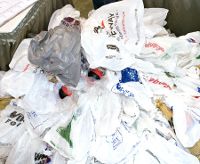The crisis of plastic pollution
Plastic is a material deliberately designed and utilised because of its durability. However, while 500 billion tonnes of plastic are consumed each year, less than 10% is recycled.

 Plastic is a material deliberately designed and utilised because of its durability. Its solid water-impermeable membrane is what makes plastic so useful for food packaging and manufacturing. However, while 500 billion tonnes of plastic are consumed each year, less than 10% is recycled.
Plastic is a material deliberately designed and utilised because of its durability. Its solid water-impermeable membrane is what makes plastic so useful for food packaging and manufacturing. However, while 500 billion tonnes of plastic are consumed each year, less than 10% is recycled.
That leaves the environment to attempt to despatch of the remaining 450 billion tonnes of the durable and impermeable solid. It's only been recently understood that plastic can break down, but only under proper conditions.
This process is known as photodegredation, or decomposition due to the sun's rays. Recent evidence suggests that some plastics actually photodegrade rapidly, and rather than be cause for celebration, it has turned out to be an even greater cause for alarm.
Plastics, intact in polymer form, are non-toxic because it remains as a whole; however, if plastic polymers are broken down into monomers such as Bisphenol A (BPA) it becomes highly toxic.
And, while research is ongoing, many believe these substances are carcinogenic-both to humans and to wildlife. They can spread with alacrity over long distances. It is also well known that BPA inhibits the reproductive systems of many animals.
The most afflictive problem is occurring within our oceans due to a combination of large plastic fragments and their toxic constituents.
Five large ocean gyres are well documented to be full of plastic waste-they exist where ocean currents meet. Yet, none is greater or more disturbing than the Great Pacific Garbage Heap, also known as the North Pacific Trash Vortex.
This area is estimated to be twice the size of Texas and is riddled with waste, filth and debris. Here, scientists from Scripps Institute of Oceanography claim to have dissected fish with guts full of plastic pieces-the fish were reportedly smaller, but those small fish are in turn eaten by large fish that might end up on a dinner plate.
Researchers believe that the amount of waste is twice the amount of living biomass in the area, and that is with fish, sea-mammals, algae and phytoplankton combined.
And, the only recently understood crisis posed by the photodegraded plastic toxins underscores the well-documented problem of large plastic debris. Plastic bags, bottles and waste are destroying wildlife.
Often indigenous animals-particularly sea birds and turtles-mistake this debris for a food source and die from ingestion.
For example, a floating plastic bag tantalizingly resembles a jellyfish to an airborne bird. Animals ingest this material and die, and their carcasses are then eaten by scavengers.
This keeps the plastic in the environment indeterminably. If the plastic sinks down to the ocean floor, then bottom dwellers such as prawns, crabs, and filter feeders are forced to cope with the waste. The world's oceans are an invaluable resource for human beings.
Algae and phytoplankton generate one third to one half of the earth's oxygen and act as huge carbon stores that help mitigate the effects of climate change. As the ocean's ecosystem declines, its ability to mitigate the effect of humanity's carbon footprint will follow.
This will play havoc on innumerable industries, from tourism, to agriculture, to drinking water. If bio-crops are expected to provide renewable resources for humanity, it is vital that action is taken to protect the oceans and end the throw-away plastic culture. While it's hard to conceptualize, biodiversity is the lifeline to our wellbeing and economy.
A degraded ocean cannot act as a carbon sink. Less carbon sinks mean higher global temperatures and unstable weather conditions, which in turn means less reliably arable land, and less arable land will make it impossible for us to regenerate renewable resources such as bioplastics.
Bioplastics offer part of the solution, and if managed and recycled properly can act as additional carbon sinks while halting further oceanic pollution. The bioplastic industry could play a huge role in delaying further environmental pollution, and for its own sake will need to do so.
Author: Michael Good |Climate Action
Image: swanksalot |Flickr






